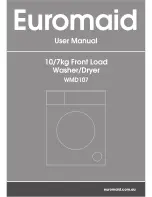
Any electrical and/or plumbing work required to install
this appliance should be carried out by a qualified
electrician and/or plumber or competent person.
Remove all packaging before positioning the machine.
If possible, position the machine next to a water tap and a
drain.
Fitting under a counter
(kitchen worktop or sink)
By removing the machine’s worktop, you can install it under a
close fitting sink unit or a pre-existing top, providing the
dimensions of the recess correspond to those shown in the
picture.
Proceed as follows:
Remove the machine’s worktop by unscrewing the two rear
retaining screws, pull the worktop from the back of the
machine and slide out the front slots, lifting the worktop.
Insert the machine after adjusting the levelling with the
adjustable feet. When inserting the machine, ensure that the
water inlet and drain hoses are not kinked or squashed.
During all operations that involve accessibility to internal
components the dishwasher has to be unplugged.
Be sure that once the appliance has been installed, it is easily
accessible for the service engineer in the event that a repair is
required.
If the dishwasher is later used as a free-standing appliance,
the original worktop must be re-mounted.
The plinth on free-standing appliances is not adjustable.
Levelling
Good levelling is essential for correct closure and sealing of
the door.
When the appliance is correctly levelled, the door will not catch
on either side of the cabinet.
If the door does not close correctly, loosen or tighten the
adjustable feet until the machine is perfectly level.
Water supply connections
This dishwasher may be fed with either hot (max. 60°) or cold
water. Nevertheless we advise you a cold water supply.
A hot water supply is not always efficient with very soiled
crockery as it shortens the washing programmes a lot.
For making the connection itself, the coupling nut fitted to the
machine’s supply hose is designed to screw onto a 3/4" inch
gas thread spout or to a purpose made quick-coupling tap
such as the Press-block.
The water pressure must be within the limits given in the
"Technical specifications". Your local Water Authority will
advise you on the average mains pressure in your area.
The water inlet hose must not be kinked, crushed, or entangled
when it is being connected.
The dishwasher features fill and drain hoses which can be
turned either to the left or the right to suit the installation by
means of the locknut. The locknut must be correctly fitted
to avoid water leaks.
(Attention! NOT all models of
dishwashers have fill and drain hoses provided with locknut. In
this case, this kind of facility is not possible).
If the machine is connected to new pipes or pipes which have
not been used for a long time, you should run the water for a
few minutes before connecting the inlet hose.
DO NOT use connection hoses which have previously
been used for an old appliance.
This appliance has been fitted with safety features which will
prevent the water used in the appliance from returning back
into the drinking water system. This appliance complies with
the applicable plumbing regulations.
Installation instructions
4
Содержание ESF 6126
Страница 1: ...D i s h w a s h e r Instruction book Model ESF 6126 ...
Страница 19: ......





































